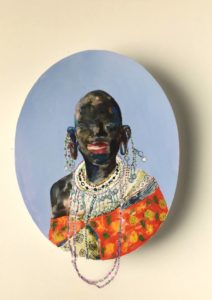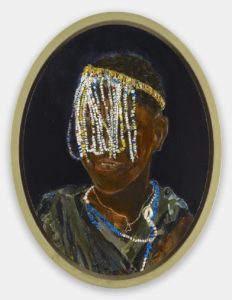
Kimberley Gundle
Victorian Masaai Portraits
About:
Gundle’s (1963) work has always been concerned with the human condition, she expresses her art in drawing, painting, mixed media, printing and ceramics. Currently Gundle is exploring the Maasai tribes of East Africa in her work. She experienced the delicate existence of these wandering people when she followed in the footsteps of these people across the base of the Great Rift Valley passing through many isolated settlements of Maasai people. Along the journey she stopped, made drawings and took photographs of the Maasai women, swathed in vibrantly coloured cloths and adorned in elaborate beadwork. These dignified bold women seek out a life from this semi-arid land. They are continually under threat from the unkind physical elements and the shifting world around them. They live a fragile existence and Gundle focuses on this aspect in her work, Since 2009 she spent time living with Maasai tribes in Kenya and in Tanzania, taking photographs and making drawings of the women.

The artist notes on her work about depicting the Maasai woman’s stages of life: the girl, the juvenile woman, and the elderly. In Gundle’s words she so beautifully comments, “I enjoy the interplay of faces, ornaments and clothes. Faces are maps of life that do not hide a person’s history, but chart past events and important happenings. Their faces echo the vast arid spaces that have formed them – yet their bright cloths and jewelry seem to push the aridity away. They are clothed in a dignified boldness in the face of their fragile existence.”

Gundle works in large scale to embody her concepts, the drawings are larger than life-size, allowing for a personal and immediate correlation with these seemingly spiritual figures. This spiritual facet is made even more evident by their omnipresence in the space they reside in. The drawings are presented as hangings, as they are as much concerned with boundaries as with space: the spaces between layers and the shapes propose the interlocking of individual lives within the Maasai community. Gundle aims to to build up an emotional and physical geography of the Maasai women by utilising the nature of the mixed media.

The background sheets which she works on are created from are hand-made Japanese paper, onto which screen-printed patterns of pieces of her grandmother’s lace are applied. The Victorian lace represents beauty, femininity, and fragility. Overlaid onto this background is the architectural film onto which the individual Maasai women are drawn. The Mylar’s translucency allows for the background lace to be seen through the figure adding to the ethereal delicateness of the piece. Gundle gives a percentage of the sales of work back to the communities with whom she is inspired by and has developed relationship with, this goes towards community projects such as schools and medical care.

